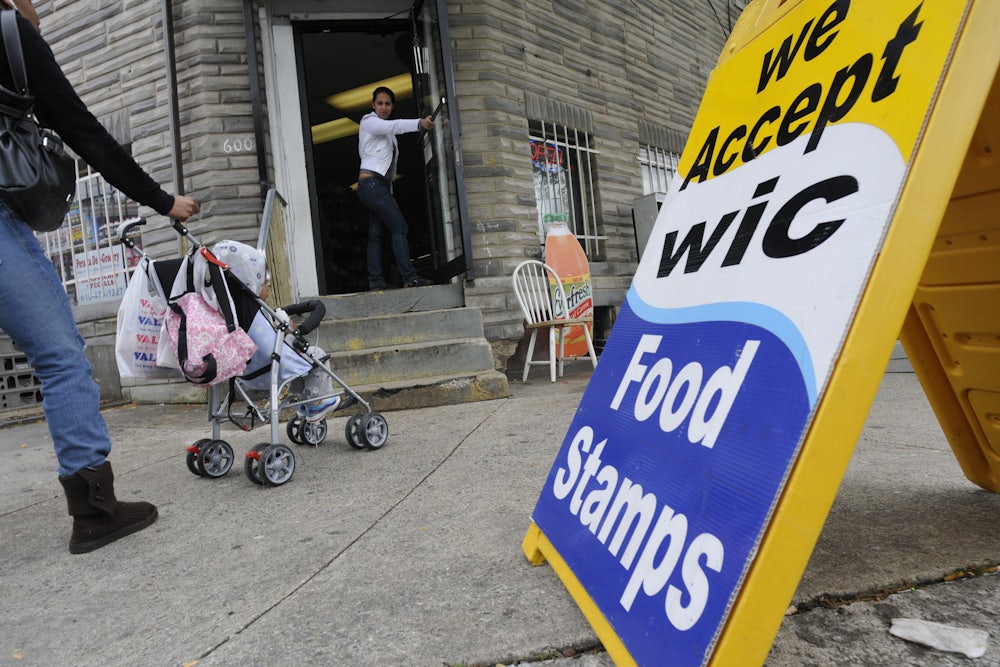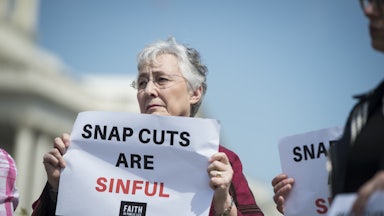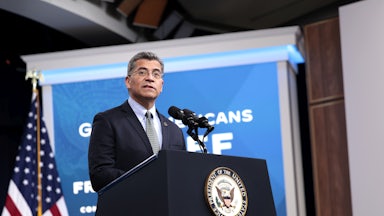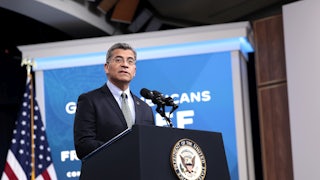Karina Burciaga had just returned home from the hospital after giving birth when her worries started to mount. The new mother wanted to breastfeed her 2-day-old daughter, Alison, but she wasn’t producing any milk. Fearing that her daughter might go hungry, and in need of some measure of comfort and security, Burciaga reached out to the office administering her benefits for Women, Infants, and Children, the federal nutrition program that assists pregnant, postpartum, and breastfeeding parents and their children under age 5, to seek advice from a lactation specialist.
“She really educated me and gave me that peace of mind, like, ‘You’re baby’s OK,’” said Burciaga, a nonprofit staffer who lives in Albuquerque, New Mexico. “But she also gave me ideas on what to do while my milk came in—a massage I could do, things I could drink, hydrate, eat.”
The specialist told her how to deliver Alison some formula so that the baby would still latch on when Burciaga produced milk. She followed up with text messages reiterating the information and then gave Burciaga a check-in call afterward. When Burciaga realized that she was not producing enough milk to feed Alison, she got on the phone with the office once more, and the staff determined that she was eligible for benefits to help pay for formula.
“The reassurance and the tools that they provided in that moment is exactly what I needed,” Burciaga recalled.
The program, commonly referred to as WIC, is critical for mothers like Burciaga. It provides financial assistance, breastfeeding support, and health care referrals for more than six million participants. Low-income families earning up to 185 percent of the federal poverty level can qualify for the program, which provides certain foods for eligible participants, as well as cash vouchers for pregnant, postpartum, and breastfeeding parents to purchase fruits and vegetables. Given the current high costs of groceries and infant formula, WIC provides a lifeline for parents who may struggle to feed themselves and their children.
“It’s really, in many ways, often a gateway program for young families in not only getting connected with benefits but also to other programs and services in their community that could be beneficial to them at that stage in their life and in their family,” said Kate Franken, the board chair of the National WIC Association, which represents provider agencies.
But WIC recipients may soon see significant cuts, or even lose these all-important benefits, if Congress does not take quick action to approve additional funding for the program. With the end of the fiscal year on September 30, WIC will need higher funding than current levels in order to maintain its rolls and benefits.
In recent years, more families have signed up for the program, in part due to expansions that occurred at the height of the coronavirus pandemic. So the cost for maintaining WIC has increased. Last week, the Biden administration asked Congress to include $1.4 billion in emergency spending for WIC as part of any short-term continuing resolution, or C.R., to extend government funding before a September 30 deadline. In a request to Congress, the Office of Management and Budget said that continuing funding for WIC at current levels in a C.R. would be insufficient, given increased food costs, higher benefit amounts, and greater participation.
The pandemic precipitated several changes to the WIC program, including temporary flexibilities that allowed eligible participants to conduct interviews remotely rather than in person—a requirement that has been particularly challenging for recipients who live in rural areas or do not have consistent access to transportation.
Congress also increased the amount of the fruit and vegetable vouchers to be in line with recommendations by the National Academies of Science, Engineering and Medicine. With inflation considerations, the voucher amounts increased to $25 per month for child participants, $44 for pregnant and postpartum participants, and $49 for fully and partially breastfeeding participants in the 2023 fiscal year.
The vouchers helped Sasheena Salvador, a WIC participant in Sanford, Florida, to maintain a more balanced diet. “I felt blessed, maybe even lucky. I didn’t realize how important it was to really incorporate fruit and vegetables into my meal, and in my daily routine,” said Salvador, who works as a part-time teacher’s aide. She lives with her mother and three brothers, and is raising her 6-month-old daughter, Aviana. Salvador’s mother participated in the WIC program, so she has benefited from it as a child and as a new mother.
In May 2023, WIC had more than 6.6 million participants, and the program paid out an average of $56 per month in benefits, according to USDA data—an increase from the same month the previous year, in which WIC had around 6.2 million participants and paid nearly $49 in benefits monthly.
“We’re seeing a higher need. Our food shelf partners and food banks, they’re seeing record numbers of folks seeking additional help as well,” said Franken. “The fact that it’s been a little bit easier to get enrolled and stay enrolled in WIC, and families have received an increase in the value of the food package from WIC, are all reasons that have contributed to this nationwide increase.”
Without the emergency funding, the White House warned that the state agencies that oversee WIC would need to implement waiting lists, which in turn would result in women and children losing their benefits. Low-income families eligible for WIC have not been subject to waiting lists in decades, Franken said.
But Congress does not seem to be treating the matter of emergency WIC funding with any real urgency. Unless Congress passes all of its appropriations bills in the next three weeks—which is all but impossible at this late hour—or approves a continuing resolution to keep the lights on until a larger spending deal can be reached, a government shutdown will begin on October 1.
Despite this threat, lawmakers have yet to draft a short-term measure extending government funding. It’s also unclear whether a “supplemental” including spending for aid to Ukraine and disaster relief would be added to a potential C.R.—and whether funding for WIC would then be attached to that supplemental. The Biden administration requested the emergency WIC funding after asking for the additional aid to Ukraine and to respond to recent natural disasters in states like Hawaii, Florida, and Vermont.
The final looming unknown: whether such a C.R., with or without any supplemental spending, could pass in the House. Republicans have a narrow majority in the lower chamber, and several hard-line conservatives have indicated that they will not support a short-term extension of government funding without conditions, like forcing a vote to commence an impeachment inquiry into President Joe Biden.
There is also the separate issue of determining WIC funding for the next fiscal year, beyond the emergency spending the White House says is required for keeping the program afloat in the short term. Senators are currently focusing their efforts on passing a “minibus” of three bipartisan appropriations bills, a process that will take several days. These measures are in line with the discretionary spending budget proposed as part of the deal between Biden and Speaker Kevin McCarthy to raise the debt ceiling in June.
However, the House spending bills are more in line with the wishes of conservative Republicans in the majority, and would dramatically slash funding below those agreed-upon levels. Although the Senate is in session this week, the House does not return to Washington until next Monday. Representatives will likely attempt to pass their appropriations bills when they return, but these will be dead on arrival in the Democratic-controlled Senate.
The agriculture appropriations bill proposed by House Republicans would cut funding for nutrition assistance, including WIC, slashing the amount of the cash vouchers for fruit and vegetable purchases. According to a report by the left-leaning Center for Budget and Policy Priorities, the Republican proposal would cut benefits for around 1.5 million pregnant, postpartum, and breastfeeding participants, as well as roughly 3.5 million children ages 1 to 4 years old. The White House contends that the House bill would cut the monthly fruit and vegetable benefits by 70 percent for pregnant women and 56 percent for children, and likely result in waiting lists for 1.9 million participants.
Many Republicans believe that spending for food assistance programs should revert to pre-pandemic levels. Representative Andy Harris, the GOP chair of the subcommittee that wrote the agriculture appropriations bill, argued in June that House Republicans were returning the vouchers to “a normal, sustainable, inflation-adjusted funding level.”
“The bill provides cash value vouchers above pre-pandemic levels to help with food price inflation caused by the Biden economy, but with the end of the public health emergency, it’s time to return this program to normal operations,” Harris, a member of the conservative Freedom Caucus, said.
In a statement to The New Republic, he also expressed opposition to the administration’s request for an additional $1.4 billion for WIC. “There is no emergency in WIC funding. [Biden’s] request can be handled through the normal appropriations process,” Harris said. “The president wants to use the Continuing Resolution as an excuse to add more spending—when our deficit is already projected to be over $2 trillion. WIC is important—so where does the president suggest we cut in order to provide these additional WIC funds?”
Still, maintaining funding for WIC has, traditionally, been a bipartisan issue. Representative Brian Fitzpatrick, a moderate Republican who has co-sponsored bipartisan legislation strengthening WIC, called the program a “critical resource” in a statement.
“There is resounding bipartisan, bicameral support for the WIC program and I look forward to continuing to support funding for these benefits as we consider the upcoming spending package,” Fitzpatrick said.
But right now, WIC is entangled with multiple controversial political issues, such as government funding and aid for Ukraine. Given those other considerations, it’s possible the request for emergency WIC funding could fall by the wayside. Republican Senator Roger Marshall, who has also co-sponsored several pieces of legislation to expand access to WIC and streamline the enrollment process, said that overstuffing a C.R. “would be a tough bill for me to swallow.”
“My problem with all this is that we’re lumping it all together—I’d rather be considering those [issues] one bucket at a time,” Marshall said about attaching supplemental funding to a C.R.
Setting aside the need for emergency funding, a government shutdown could affect how WIC is distributed. With no federal spending on WIC, states would only be able to administer the program for as long as their leftover funds lasted. During the weeks-long shutdown that began at the end of 2018 and lasted through the end of January 2019, states came worryingly close to cutting benefits or instituting waiting lists.
“Ultimately, we really are relying on Congress to keep their long-standing bipartisan commitment to providing WIC with the resources that are needed to preserve the benefits of the program, and to continue serving all those folks seeking services,” said Franken.
In an era of heightened political polarization, however, relying on Congress could be a risky bet. But for mothers like Burciaga and Salvador, members of Congress represent their hope for continued benefits, and the threat of losing them.
“The only assistance I get from the government is health insurance and WIC. With the inflation on everything, if WIC was to go away, I’d be devastated emotionally, I’d be stressed mentally, and I would probably be sick physically,” said Salvador. “What I want to see Congress do is take this seriously … because it matters. It helps, it provides, it keeps people alive.”










